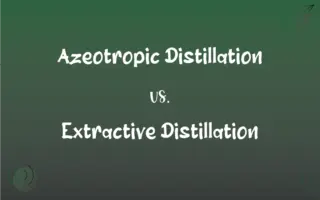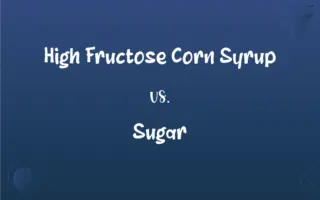Mold vs. Yeast: What's the Difference?
Edited by Aimie Carlson || By Harlon Moss || Published on March 18, 2024
Mold is a multicellular fungus that grows in filaments and reproduces via spores; yeast is unicellular, reproduces by budding or fission, and is used in fermentation.

Key Differences
Mold and yeast are both types of fungi, but they differ significantly in appearance, structure, and function. Mold is typically visible to the naked eye as fuzzy or slimy patches of various colors and consists of long, thread-like structures called hyphae. These hyphae form a network called a mycelium, which penetrates the growth surface. Yeast, on the other hand, is usually unicellular, appearing as tiny, round cells under a microscope. Unlike mold, yeast is often used in the production of bread, beer, and wine due to its fermentation capabilities, converting sugars into alcohol and carbon dioxide.
Mold thrives in warm, damp, and humid conditions, spreading quickly across surfaces by producing spores, while yeast prefers liquid or moist environments where it can absorb nutrients. Mold is known for its role in decomposing organic matter, but some species are used in food production, such as cheese making. Yeast, besides its pivotal role in fermentation, is also important in biotechnology for producing ethanol and other biochemical products. The reproduction of mold through spores allows it to spread rapidly and colonize new areas, whereas yeast reproduces asexually through a process called budding, where a new cell grows directly from the original cell's body.
In terms of health implications, some molds can produce mycotoxins, which are harmful to human and animal health, leading to allergic reactions, respiratory issues, and in severe cases, poisoning. Yeast, particularly the species Saccharomyces cerevisiae, is generally regarded as safe and is extensively used in the food industry. However, overgrowth of certain yeast species in the body, such as Candida, can lead to infections such as thrush.
Despite their differences, both mold and yeast play essential roles in their ecosystems. Mold's ability to break down complex organic compounds makes it a key player in the decomposition process, recycling nutrients back into the environment. Yeast's fermentation process is not only crucial for food and beverage production but also has significant applications in science, especially in genetics and molecular biology research. Understanding the distinct characteristics of mold and yeast is essential for their proper utilization and management in both industrial and environmental contexts.
Comparison Chart
Cell Structure
Multicellular, forms hyphae and mycelium
Unicellular, oval or spherical cells
ADVERTISEMENT
Reproduction
Spores
Budding or fission
Uses
Food production (cheese), decomposition
Fermentation (bread, beer, wine)
Growth Conditions
Warm, damp surfaces
Liquid or moist environments
Health Implications
Some produce mycotoxins, can cause allergies
Generally safe, overgrowth can cause infections
Mold and Yeast Definitions
Mold
Can be beneficial in food production or harmful when producing toxins.
Blue cheese gets its flavor from a specific type of edible mold.
ADVERTISEMENT
Yeast
A single-celled fungus used in baking and brewing for fermentation.
She added yeast to the dough to make it rise.
Mold
Reproduces by releasing spores into the air.
When you disturb moldy bread, the spores can spread through the air.
Yeast
Converts sugars into alcohol and carbon dioxide during fermentation.
The yeast worked overnight, fermenting the grape juice into wine.
Mold
A common issue in houses with poor ventilation and moisture problems.
We had to hire a professional to remove the mold in our basement.
Yeast
Can be found naturally on the skins of fruits and in the environment.
Wild yeast from the air started the fermentation process in the sourdough.
Mold
A fungus that grows in the form of multicellular filaments called hyphae.
The bread was left out too long and now it's covered in green mold.
Yeast
Microorganisms involved in fermentation, often used in scientific research and biotechnology.
Scientists are studying yeast to develop new biofuels.
Mold
Thrives in moist, warm environments and can decompose organic material.
The mold on the wall is a sign of a serious dampness problem.
Yeast
Used in biotechnology for producing biofuels and pharmaceuticals.
Researchers are using yeast to develop a new class of biofuels.
Mold
A hollow form or matrix for shaping a fluid or plastic substance.
Yeast
Any of various unicellular fungi of the genus Saccharomyces, especially S. cerevisiae, reproducing asexually by budding or sexually through the production of ascospores and capable of fermenting carbohydrates.
Mold
A frame or model around or on which something is formed or shaped.
Yeast
Any of numerous fungi that exhibit a one-celled growth form and reproduce by budding, including certain candidas that can cause infections in humans.
FAQs
Are mold and yeast harmful?
Some species can be harmful, producing toxins, but others are beneficial and used in food production and medicine.
Can mold grow on bread like yeast?
Yes, mold can grow on bread, but unlike yeast, it is unwanted and indicates spoilage.
What is mold?
Mold is a type of fungus that grows in multicellular filaments called hyphae, thriving in damp conditions.
How does mold reproduce?
Mold reproduces through spores, which are spread by air, water, or animals.
How can I prevent mold growth at home?
Keep your home dry, clean, and well-ventilated to prevent mold growth.
What is yeast?
Yeast is a single-celled microorganism part of the fungus kingdom, used in fermentation to produce bread, beer, and wine.
How can you tell mold and yeast apart?
Mold appears as fuzzy, colorful patches, while yeast is usually white or cream-colored and powdery.
Can mold be used in food production?
Yes, certain molds are used to produce cheeses, soy sauce, and other fermented foods.
Is yeast alive?
Yes, yeast is a living organism that feeds on sugars, producing carbon dioxide and alcohol during fermentation.
How do you kill mold?
Mold can be killed with cleaning solutions like bleach, vinegar, or specialized mold removal products.
What role does mold play in the environment?
Mold decomposes organic material, recycling nutrients back into the ecosystem.
Can mold and yeast be found in the same environment?
Yes, both can exist in the same environments, especially in places where moisture and organic material are present.
How is yeast used in brewing?
In brewing, yeast ferments sugars from grains, producing alcohol and carbonation.
What distinguishes yeast infections from mold infections?
Yeast infections are typically caused by Candida species affecting skin or mucous membranes, while mold infections can affect the respiratory system or skin but are less common in healthy individuals.
Can yeast cause infections?
Some yeast species, like Candida, can cause infections, especially in individuals with weakened immune systems.
What conditions do yeast thrive in?
Yeast thrives in warm, moist environments with a source of sugar for fermentation.
Can mold be beneficial?
Yes, some molds are beneficial for producing antibiotics like penicillin and for food production.
What are the health risks of mold exposure?
Exposure can cause allergic reactions, respiratory problems, and in rare cases, more severe health issues.
Is it safe to eat food with yeast?
Yes, yeast is safe and often beneficial in food production, such as in bread and alcoholic beverages.
How is yeast harvested?
Yeast is cultivated and harvested in controlled conditions to ensure purity and effectiveness for specific uses.
About Author
Written by
Harlon MossHarlon is a seasoned quality moderator and accomplished content writer for Difference Wiki. An alumnus of the prestigious University of California, he earned his degree in Computer Science. Leveraging his academic background, Harlon brings a meticulous and informed perspective to his work, ensuring content accuracy and excellence.
Edited by
Aimie CarlsonAimie Carlson, holding a master's degree in English literature, is a fervent English language enthusiast. She lends her writing talents to Difference Wiki, a prominent website that specializes in comparisons, offering readers insightful analyses that both captivate and inform.







































































